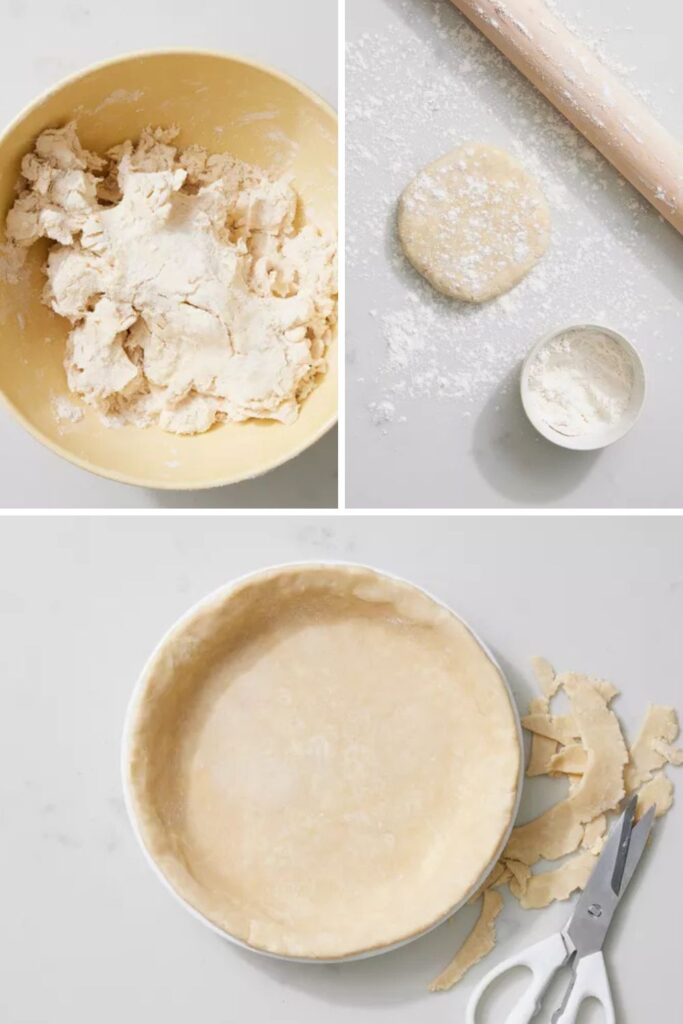The flour was already on the counter.
I don’t remember putting it there.
It was raining hard enough that the windows steamed. The dog wouldn’t stop pacing. And Mae had texted “Do you still make that crust that fights you?”
Which felt like a dare. Or a memory. Or both.
I opened Martha’s book like I was opening a box I shouldn’t touch.
The pie crust was right there—marked with a paperclip that used to hold a photo of my grandmother.
So I started.
What the Original Looked Like
Her Highness’s pie crust isn’t loud. It’s not trendy.
It’s butter-heavy. Cold. Simple. Dignified. Like everything she touches.
Flour, salt, sugar. Then ice water, whispered in. Just enough to hold things together, but never too much. That’s the rule.
The butter stays visible. That’s the trick. It’s not meant to disappear—it’s meant to layer.
She tells you to chill it, roll it, fold it under like it’s nothing. Like it won’t crumble in your hands if you think too hard.
What I Did Differently (And Why I Knew I Would)
I didn’t use a pastry cutter. I never do.
I use two knives like she did. Not Martha—my grandmother.
Her crusts were dry. Crumbly. A little bitter, if I’m honest.
But she always smiled like they were perfect.
I added a little more salt than called for. Because I was mad.
Used the cheap butter, too. Because it was what I had.
And I didn’t chill it long enough. Because I was tired of waiting.
The Way It Happened in My Kitchen
I cut the butter into the flour with the old knives—the ones with black handles and dents in the blade.
The mixture didn’t look right. Too powdery. I added a splash of water. Then another.
The dough barely came together. I pressed it anyway.
Wrapped it in plastic. Threw it in the fridge.
Paced for an hour. Forgot about it. Came back when the room smelled like cold.
I rolled it out on the old wooden board—the one with the scorch mark in the corner from that candle incident.
It cracked on the edges. I patched it. It tore in the middle. I patched that too.
Laid it into the buttered tin like I was laying down a blanket.
One with holes. One with history.
I folded the edges under, like Martha said. Like Nan used to.
It looked better than I expected.
But it still felt like grief.
Why I’ll Never Follow This Recipe Without Remembering Her
She never used sugar in the crust. Said it was “for cheaters.”
Martha does. I like it. I don’t tell her that.
Every time I roll dough, I hear her laugh.
The sharp one. The one she saved for when things didn’t work, but she made them anyway.
A Few Things I Learned
Pie dough doesn’t forgive your mood. It mirrors it.
Too much handling = a fight.
Too little = it falls apart when no one’s looking.
It held together this time.
Just barely.
Like me.
What I Did With the Extras
Scraps went in the freezer. I said I’d make hand pies.
I won’t.
Would I Make It Again?
Yes.
When I need to feel her hands beside mine.
Even if I flinch when I do.
If you want something that forgives more easily, I made Martha’s chocolate chip cookies last week—no ghosts, just butter and sugar and Mae licking the spoon.

FAQs
Yes. Just wrap it tight. It keeps for a month, maybe more. Just don’t forget it like I did once—found it wedged behind frozen peas and a 2019 regret.
Use two knives. Or your hands, fast and cold. I’ve even used a fork in a pinch. It’s about texture, not tools.
Yep. The base is neutral. Add a pinch more sugar for fruit pies. Leave it as-is for quiche or something with mushrooms and cheese (which you should absolutely do).
Because it’s finicky. Maybe it was too cold. Maybe you were too rough. Pat the cracks closed like they’re small heartbreaks. It’ll bake fine.
You do. Sorry. I’ve tried skipping it. It punishes you. Think of it as letting the dough rest while you do the same.
Check out More Recipes:
- Martha Stewart Turkey Burger
- Martha Stewart Turkey Meatballs
- Martha Stewart Turkey Chili
- Martha Stewart Chocolate Chip Cookies

Martha Stewart Pie Crust
Description
Cold, fragile, and stitched with memory. Like a letter I never sent.
Ingredients
Instructions
- Cube the butter: Cut into 8 pieces. Chill it again. Cold means layers. Cold means it might hold.
- Mix the dry stuff: Flour, salt, sugar—into the big bowl. The one that always smells faintly like cinnamon, no matter how often you wash it.
- Cut in the butter: Use a pastry cutter. Or two knives. Or your hands, fast. Stop when it looks like beach sand with butter pebbles hiding inside.
- Add the water: One spoon at a time. Stir gently. Press. If it holds, stop. If it crumbles, add another splash. If it fights you, don’t fight back. Just wait.
- Wrap and chill: Split the dough in two. Wrap in plastic. Refrigerate an hour. Forget about it. Let it become itself.
- Roll it out: Flour everything. Rolling pin, counter, your patience. Turn it often. Patch what tears.
- Fit it in the tin: Butter the dish. Lay the dough gently. Pat it like it’s someone you’re trying to forgive.
- Trim and fold: Leave a 1-inch overhang. Fold it under. Press with fingers. Or don’t. Let it be jagged. Let it be real.
